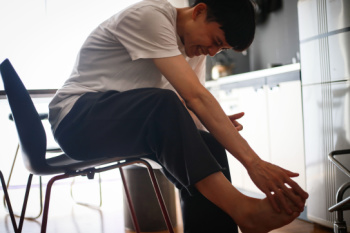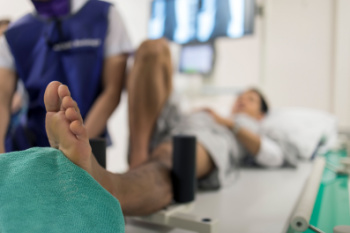Items filtered by date: May 2025
Managing Gout With Ongoing Treatment

Gout is a chronic inflammatory form of arthritis that often affects the joints of the feet, particularly the big toe. During a gout flare-up, the affected joint may become intensely painful, swollen, and red due to the buildup of uric acid crystals. While there is no cure for gout, medical treatment can help reduce the frequency and intensity of flare-ups and limit joint damage. A podiatrist can diagnose gout and recommend treatment options that lower uric acid levels and manage inflammation. These may include medication that reduces pain and swelling, as well as long-term prescriptions aimed at preventing recurrences. Without proper treatment, gout may lead to joint deformity or permanent damage in the feet or ankles. Timely care from a podiatrist can shorten flare-ups, which typically peak within 24 hours and may last several days. If you suffer from flare-ups of gout, it is suggested that you schedule regular appointments with a podiatrist for ongoing treatment.
Gout is a painful condition that can be treated. If you are seeking treatment, contact Barbara J. Aung, DPM from Aung Foot Health Clinic . Our doctor will treat your foot and ankle needs.
What Is Gout?
Gout is a form of arthritis that is characterized by sudden, severe attacks of pain, redness, and tenderness in the joints. The condition usually affects the joint at the base of the big toe. A gout attack can occur at any random time, such as the middle of the night while you are asleep.
Symptoms
- Intense Joint Pain - Usually around the large joint of your big toe, and it most severe within the first four to twelve hours
- Lingering Discomfort - Joint discomfort may last from a few days to a few weeks
- Inflammation and Redness -Affected joints may become swollen, tender, warm and red
- Limited Range of Motion - May experience a decrease in joint mobility
Risk Factors
- Genetics - If family members have gout, you’re more likely to have it
- Medications - Diuretic medications can raise uric acid levels
- Gender/Age - Gout is more common in men until the age of 60. It is believed that estrogen protects women until that point
- Diet - Eating red meat and shellfish increases your risk
- Alcohol - Having more than two alcoholic drinks per day increases your risk
- Obesity - Obese people are at a higher risk for gout
Prior to visiting your podiatrist to receive treatment for gout, there are a few things you should do beforehand. If you have gout you should write down your symptoms--including when they started and how often you experience them, important medical information you may have, and any questions you may have. Writing down these three things will help your podiatrist in assessing your specific situation so that he or she may provide the best route of treatment for you.
If you have any questions, please feel free to contact our office located in Tuscon, AZ . We offer the newest diagnostic and treatment technologies for all your foot care needs.
Five Causes of Foot Pain

Foot pain can limit daily movement and may stem from a variety of medical conditions that affect the toes, soles, and ankles. Common causes of foot pain include bunions, fallen arches, hammertoes, ingrown toenails, and plantar fasciitis. Bunions are bony growths at the base of the big toe that may lead to joint pain and swelling. A podiatrist may recommend surgery if the condition interferes with walking. Fallen arches, or flat feet, can create strain in the arch and ankle and may be managed with wearing supportive footwear and medical treatment to improve alignment. Hammertoes involve an abnormal bend in the smaller toe joints, often leading to irritation or pressure against shoes. In some cases, surgery may be needed to correct this deformity. Ingrown toenails develop when the edge of a nail grows into the surrounding skin, causing pain and sometimes infection, which may require part of the nail to be removed. Additionally, plantar fasciitis results from tiny tears in the band of tissue beneath the foot and often causes sharp heel pain. If you are experiencing foot pain, it is suggested that you schedule an appointment with a podiatrist for an exam, diagnosis, and appropriate treatment.
Foot Pain
Foot pain can be extremely painful and debilitating. If you have a foot pain, consult with Barbara J. Aung, DPM from Aung Foot Health Clinic . Our doctor will assess your condition and provide you with quality foot and ankle treatment.
Causes
Foot pain is a very broad condition that could be caused by one or more ailments. The most common include:
- Bunions
- Hammertoes
- Plantar Fasciitis
- Bone Spurs
- Corns
- Tarsal Tunnel Syndrome
- Ingrown Toenails
- Arthritis (such as Gout, Rheumatoid, and Osteoarthritis)
- Flat Feet
- Injury (from stress fractures, broken toe, foot, ankle, Achilles tendon ruptures, and sprains)
- And more
Diagnosis
To figure out the cause of foot pain, podiatrists utilize several different methods. This can range from simple visual inspections and sensation tests to X-rays and MRI scans. Prior medical history, family medical history, and any recent physical traumatic events will all be taken into consideration for a proper diagnosis.
Treatment
Treatment depends upon the cause of the foot pain. Whether it is resting, staying off the foot, or having surgery; podiatrists have a number of treatment options available for foot pain.
If you have any questions, please feel free to contact our office located in Tuscon, AZ . We offer the newest diagnostic and treatment technologies for all your foot care needs.
Understanding Sever's Disease in Growing Feet

Sever's disease is a common cause of heel pain in children and young teens, especially those who participate in sports. It is not actually a disease but a growth-related condition that affects the heel’s growth plate. As the foot grows, the Achilles tendon can pull on the developing heel bone, causing pain and swelling. Running and jumping often make it worse, and the heel may feel sore to the touch. The pain usually comes and goes, and may be more noticeable after activity. Rest and stretching can help ease symptoms. Wearing supportive shoes or heel cushions may also reduce strain. Most children outgrow the condition once their bones finish growing. If your child complains of heel pain during or after sports, it is suggested you see a podiatrist for a proper diagnosis and appropriate treatment.
Sever's disease often occurs in children and teens. If your child is experiencing foot or ankle pain, see Barbara J. Aung, DPM from Aung Foot Health Clinic . Our doctor can treat your child’s foot and ankle needs.
Sever’s Disease
Sever’s disease is also known as calcaneal apophysitis, which is a medical condition that causes heel pain I none or both feet. The disease is known to affect children between the ages of 8 and 14.
Sever’s disease occurs when part of the child’s heel known as the growth plate (calcaneal epiphysis) is attached to the Achilles tendon. This area can suffer injury when the muscles and tendons of the growing foot do not keep pace with bone growth. Therefore, the constant pain which one experiences at the back of the heel will make the child unable to put any weight on the heel. The child is then forced to walk on their toes.
Symptoms
Acute pain – Pain associated with Sever’s disease is usually felt in the heel when the child engages in physical activity such as walking, jumping and or running.
Highly active – Children who are very active are among the most susceptible in experiencing Sever’s disease, because of the stress and tension placed on their feet.
If you have any questions, please feel free to contact our office located in Tuscon, AZ . We offer the newest diagnostic and treatment technologies for all your foot care needs.
Reminder: When Was the Last Time...?
History and Risks of Foot Stress Fractures

Foot stress fractures are tiny cracks in the bones of the foot caused by repetitive stress and overuse rather than a sudden injury. They were first described in 1855 by Prussian soldiers who developed these injuries after long marches, leading to the term “march fractures.” These fractures often affect the metatarsal bones and are common in individuals who suddenly increase their physical activity or endure prolonged periods of weight-bearing exercise. Symptoms include localized pain that worsens with activity, swelling, and tenderness in the affected area. Risk factors for developing foot stress fractures include participating in high-impact sports, wearing improper footwear, having weakened bones from conditions like osteoporosis, and poor nutritional intake. If you have symptoms of a foot stress fracture, it is suggested that you visit a podiatrist who can accurately diagnose and treat this condition.
Activities where too much pressure is put on the feet can cause stress fractures. To learn more, contact Barbara J. Aung, DPM from Aung Foot Health Clinic . Our doctor can provide the care you need to keep your pain free and on your feet.
Dealing with Stress Fractures of the Foot and Ankle
Stress fractures occur in the foot and ankle when muscles in these areas weaken from too much or too little use. The feet and ankles then lose support when walking or running from the impact of the ground. Since there is no protection, the bones receive the full impact of each step. Stress on the feet can cause cracks to form in the bones, thus creating stress fractures.
What Are Stress Fractures?
Stress fractures occur frequently in individuals whose daily activities cause great impact on the feet and ankles. Stress factors are most common among:
- Runners
- People affected with Osteoporosis
- Tennis or basketball players
- Gymnasts
- High impact workouts
Symptoms
Pain from the fractures occur in the area of the fractures and can be constant or intermittent. It will often cause sharp or dull pain with swelling and tenderness. Engaging in any kind of activity which involves high impact will aggravate pain.
If you have any questions please contact our office located in Tuscon, AZ . We offer the newest diagnostic and treatment technologies for all your foot and ankle needs.






